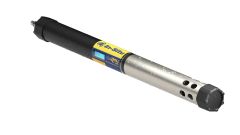

Overview
When Hong Kong International Airport undertook a massive construction project to add three new runway systems, they needed to reclaim land almost equal in size to the existing airport island. To minimize environmental impact, the project employed deep cement mixing, a non-dredging method of land reclamation, and monitored the process continuously to ensure minimal disturbance of the surrounding ecosystem.
Challenge
The Three-Runway System (3RS) project involved several construction initiatives including new and expanded Terminal 2 concourses, a 3,800 meter runway and supporting taxiway systems, a tram system to move passengers between Terminal 2 and the Terminal 2 Concourse and a new baggage handling system.
This required creating an offshore building site almost equal in size to the existing airport. Dredging for a project of this scale would create substantial disturbances in the surrounding environment, so the Hong Kong Airport Authority opted to use Deep Cement Mixing (DCM) to generate the building material for the 3RS project.
This required creating an offshore building site almost equal in size to the existing airport. Dredging for a project of this scale would create substantial disturbances in the surrounding environment, so the Hong Kong Airport Authority opted to use Deep Cement Mixing (DCM) to generate the building material for the 3RS project.
Solution
DCM removes the need for dredging of the marine deposit before reclamation, making it a lower-impact construction method. Forty percent of the building location for the 3RS project was located on contaminated mud pits, so a non-dredging method was particularly important to limit potential leakages.
DCM rigs were drilled into the seabed below the building site and cement was injected into the contaminated mud to form cement clusters. The cement clusters increased the solidity of the mud and prevented leakages into the surrounding water.
Hong Kong Airport Authority hired Fugro, an environmental monitoring consulting firm, to monitor the impact of deep cement mixing on the environment. Fugro installed four Aqua TROLL 600s at each DCM barge for real-time monitoring of dissolved oxygen, turbidity, pH, salinity and ammonia during the process. Fugro used 100 Aqua TROLLs in total and connected them to a third-party logger to transmit their data.
Biofouling presents a persistent challenge in any marine environment. The 3RS project was no exception, but Fugro consultants found a clever workaround. They wrapped the Aqua TROLL restrictors in a plastic sleeve to prevent organisms from growing directly on the sonde. This reduced the necessary maintenance to periodic cleaning of the sensor faces and replacement of the sleeve.
DCM rigs were drilled into the seabed below the building site and cement was injected into the contaminated mud to form cement clusters. The cement clusters increased the solidity of the mud and prevented leakages into the surrounding water.
Hong Kong Airport Authority hired Fugro, an environmental monitoring consulting firm, to monitor the impact of deep cement mixing on the environment. Fugro installed four Aqua TROLL 600s at each DCM barge for real-time monitoring of dissolved oxygen, turbidity, pH, salinity and ammonia during the process. Fugro used 100 Aqua TROLLs in total and connected them to a third-party logger to transmit their data.
Biofouling presents a persistent challenge in any marine environment. The 3RS project was no exception, but Fugro consultants found a clever workaround. They wrapped the Aqua TROLL restrictors in a plastic sleeve to prevent organisms from growing directly on the sonde. This reduced the necessary maintenance to periodic cleaning of the sensor faces and replacement of the sleeve.
Results
Having continuous data on the water quality around the DCM rigs allowed project managers to make sure the rigs were functioning as intended and that no leakages or contamination entered the surrounding waters.
“We are pleased to report that the product has fulfilled the task to satisfaction,” says Dr. William Fung, Instrumentation Manager at Fugro, “We will be pleased to utilize the product again in the future and would have no hesitation recommending it for similar work elsewhere.”
The 3RS project has been in planning stages since 2008, with construction beginning in 2016. After years of hard work, the 3RS runway began operation in July 2022, with the expansion of Terminal 2 and completion of the new concourse on track for a 2024 opening.
“We are pleased to report that the product has fulfilled the task to satisfaction,” says Dr. William Fung, Instrumentation Manager at Fugro, “We will be pleased to utilize the product again in the future and would have no hesitation recommending it for similar work elsewhere.”
The 3RS project has been in planning stages since 2008, with construction beginning in 2016. After years of hard work, the 3RS runway began operation in July 2022, with the expansion of Terminal 2 and completion of the new concourse on track for a 2024 opening.







